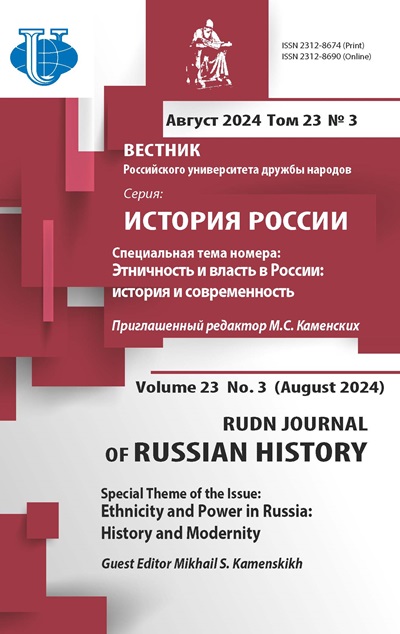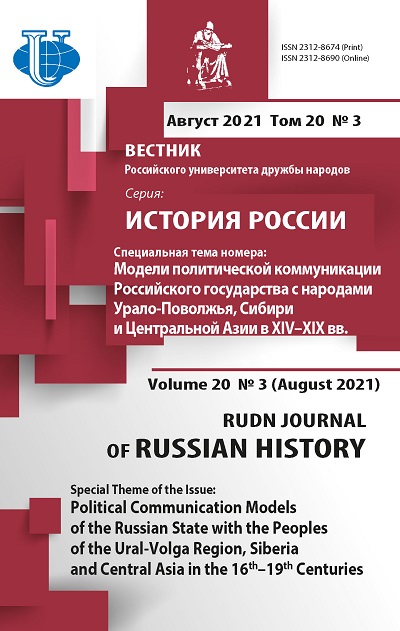The ulus elite of the Yakuts in the communicative space of the Russian state from the 17th to 19th centuries
- Authors: Borisov A.A.1
-
Affiliations:
- Institute of Humanities and Indigenous Peoples, North Siberian Branch Russian Academy of Sciences
- Issue: Vol 20, No 3 (2021): Political Communication Models of the Russian State with the Peoples of the Ural-Volga Region, Siberia and Central Asia in the 16th–19th Centuries
- Pages: 353-364
- Section: Political Communication Models of the Russian State with the Peoples of the Ural-Volga Region, Siberia and Central Asia in the 16th–19th Centuries
- URL: https://journals.rudn.ru/russian-history/article/view/27267
- DOI: https://doi.org/10.22363/2312-8674-2021-20-3-353-364
Cite item
Full text / tables, figures
Abstract
The article discusses the incorporation of the elite of the Yakut uluses - traditional potestary institutions - into the Russian state through its communicative space. At the same time, a new interpretation of uluses is given as a special political form of organization of nomadic peoples. In view of their dispersed and mobile lifestyle, communication played an important role among them. With titles such as toyons, kniastsy , and "best people", the taxonomy of the representatives of the Yakut elite finds analogies among other nomadic peoples. The article discusses the genealogical principle of the legitimacy of power and the governance practice of the Russian state in Yakutia. This article breaks new ground by analyzing the routes and forms of political communication through which the influence of the Russian state on the ulus system in general and on the ulus elite in particular was carried out. The activities of the provincial administration in relation to toyons to make them Russian subjects are interpreted as a route for the formation of the communication space in the imperial outskirts. The delegations of the Yakut nobles to the Russian tsars of the 17th and 18th centuries, and the inclusion of Yakut elite representatives into the Russian nobility, expanded this space by increasing the Yakuts’ confidence in the ruling regime. The article also takes account of local features of this process, which influenced the rate and nature of incorporation. The paper characterizes the communicative practices of embedding the Yakut ulus elite into the district governance system of Yakutia. The author argues that typologically, the ideas of citizenship adopted in the Russian state and in the Yakut ulus elite coincided. The Yakut nobles, apparently, did not differ in this from the related Turkic-Mongol elites of Southern and Western Siberia, but differed, in turn, in the pace of transition to tsarist power, since the former had an alternative in the face of politically strong neighbors, for example, Dzungaria.
Keywords
About the authors
Andrian A. Borisov
Institute of Humanities and Indigenous Peoples, North Siberian Branch Russian Academy of Sciences
Author for correspondence.
Email: a_a_borisov@mail.ru
Doctor Istoricheskikh Nauk [Dr. habil. hist.], Senior Research Scientist of the Institute of Humanities and Indigenous Peoples, North Siberian Branch Russian Academy of Sciences.
1, Petrovskogo Str., Yakutsk, 677027, RussiaReferences
- Basharin, G.P. Istoriia agrarnykh otnoshenii v Yakutii. Vol. 2. Moscow: Art-Fleks Publ., 2003 (in Russian).
- Bolo, S.I. Proshloe yakutov do prikhoda russkikh na Lenu (po predaniyam yakutov byvshego Yakutskogo okruga). Yakutsk: Yakutskoe gosudarstvennoe izdatel’stvo Publ., 1938 (in Russian).
- Borisov, A.A., ed. Istoriia doliny Enzieli v russkikh dokumentakh XVII veka. Sb. dokumentov. Issue 1. Irkutsk: Ottisk Publ., 2019 (in Russian).
- Gavra, D.P. Osnovy teorii kommunikatsii. St. Peterburg: Piter Publ., 2011 (in Russian).
- Gogolev, A.I. Yakuty (problem etnogeneza i formirovaniya kultury). Yakutsk: YGU Publ, 1993 (in Russian).
- Ionova, O.V. Iz istorii yakutskogo naroda. Yakutsk: Gos. izd-vo YaASSR Publ., 1945 (in Russian).
- Ivanov, V.F. Russkie pis'mennye istochniki po istorii Yakutii XVIII – nachala XIX v. Novosibirsk: Nauka. Sib. otd-nie Publ., 1991 (in Russian).
- Ivanov, V.N. Sostial'no-ekonomicheskie otnosheniia yakutov. XVII vek. Yakutsk: Kn. izd-vo Publ., 1966 (in Russian).
- Kappeler, A. Rossiya – mnogonastional'naia imperiia. Vozniknovenie, istoriia, raspad. Moscow: Progress-Traditsiya Publ., 2000 (in Russian).
- Kradin, N.N., and Skrynnikova, T.D. Imperiia Chingis-khana. Moscow: Vost. lit. Publ., 2006 (in Russian).
- Ksenofontov, G.V. Elleyada. Materialy po mifologii i legendarnoi istorii yakutov. Moscow: Nauka Publ., 1977 (in Russian).
- Kychanov, E.I. Istoriia prigranichnykh s Kitaem drevnikh i srednevekovykh gosudarstv (ot gunnov do manchzhurov). St. Petersburg: Peterburgskoe lingvisticheskoe obshhestvo Publ., 2010 (in Russian).
- Linde, A.N. “Problem of ratio between humanistic and technological directions in theory of social-political communications.” Communications. Media. Design 2, no. 2 (2017): 87–92.
- Lotman, Yu.M. Semiosfera. St. Petersburg: Iskusstvo-SPb Publ., 2000 (in Russian).
- Miller, G.F. Istoriia Sibiri. Vol. 3. Moscow: Vostochnaya literatura Publ., 1999 (in Russian).
- Samrina, E.V. Khakassko-Minusinskii krai v XVII–XVIII vv. (Transformatsiia tradistionnoi zhiznedeiatel'nosti khakasov). Makhachkala: KhakNIIYLI Publ., 2015 (in Russian).
- Sokolov, A.V. Sotsial’nye kommunikatsii. St. Peterburg: Professia Publ., 2013 (in Russian).
- Tokarev, S.A. Obshhestvennyy stroy yakutov XVII–XVIII vv. Yakutsk: Yakut. gos. izd-vo Publ., 1945 (in Russian).
- Tokarev, S.A. Ocherk istorii yakutskogo naroda. Moscow: Gos. sost.-ekon. izd-vo Publ., 1940 (in Russian).
- Trepavlov, V.V. ‘Belyy car’: obraz monarkha i predstavleniia o poddanstve u narodov Rossii XV–XVIII vv. Moscow: Vostochnaia literatura Publ., 2007 (in Russian).
- Zuev, A.S. “Aborigennaia (inorodcheskaia) politika Rossii v Sibiri.” Istoricheskaia entsiklopediia Sibiri. Vol. 1. Novosibirsk: Ist. nasledie Sibiri Publ., 2010: 9–14 (in Russian).
- Zuev, A.S., Ignatkin, P.S., and Slugina, V.A. Pod sen' dvuglavogo orla: inkorporatsiia narodov Sibiri v Rossiiskoe gosudarstvo v kontse XVI – nachale XVIII v. Novosibirsk: IPC NGU Publ., 2017 (in Russian).
















